Summary: Agile methodology links the cycle of requirements and development and brings faster product deployment, keeping all necessary iterations in the loop. With its tenets of people over processes, emphasis on customer needs & quick response to change, the working process is guided by the Agile Manifesto. The Manifesto forms an outline for the agile values & principles that guide the full operability of this methodology. Here’s a quick round-up of the Agile Manifesto and how to use them for your business advantage.
Agile development has become a standard process due to its transparency and quick results. It impacts modern software development methods with fresh alternatives and credibility. Agile Manifesto’s customer-centric approach is more relevant today than in 2001, when the Manifesto was first laid out by a group of 17 developers in Utah. Many organizations have monitored a project’s progress and success.
The State of Agile Report 2021 by Digital.ai points out that Agile adoption in software development firms, for example, increased from 37% in 2020 to 86% n 2021. Agile development is based on the vital agile principles & values that offer both an iterative and an incremental set of practices for management. It allows development teams to focus on the quick delivery of business value in a progressive landscape.
All Agile project management techniques, such as Scrum development, Kanban, and XP, support the Agile Manifesto to offer seamless development, higher productivity, greater adaptability, and superior product delivery, thereby leading an Agile transformation of an organization.
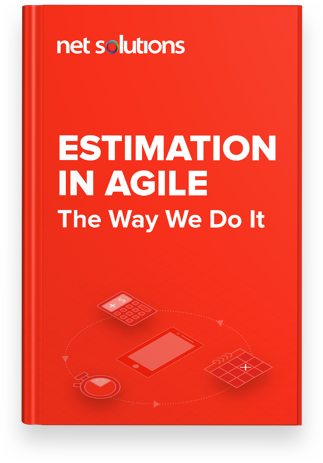
We respect your privacy. Your information is safe.
Origins of the Agile Manifesto
During the ’90s, one of the significant challenges for organizations was the considerable time gap between the determination of business requirements (requests from the customers) and the delivery of the solutions that could fulfill the relevant demands. By the time the final product became ready, it would also be redundant since the customer requisites would have changed owing to the lag. Speed and agility had become a significant cause of concern for Product Development, and the widely used Waterfall model was incapable of solving it.
The disappointments around the lack of productivity in software development led to 17 thought leaders teaming up in 2001 at a ski resort in Utah to develop a solution. The result was the Agile Manifesto and its principles. Several organizations worldwide have extensively used this document, paving the way for new approaches to software development.
What is the Agile Manifesto?
The Manifesto starkly differentiates itself from the traditional methods in a brief document with 4 values and 12 principles for agile software development. The Agile Manifesto continues to reshape the software development processes while emphasizing the customer’s needs. However, it does not impose any process or guideline for the agile methodology; instead, it provides a theoretical approach to software development through the agile principles and values.
12 Principles of the Agile manifesto
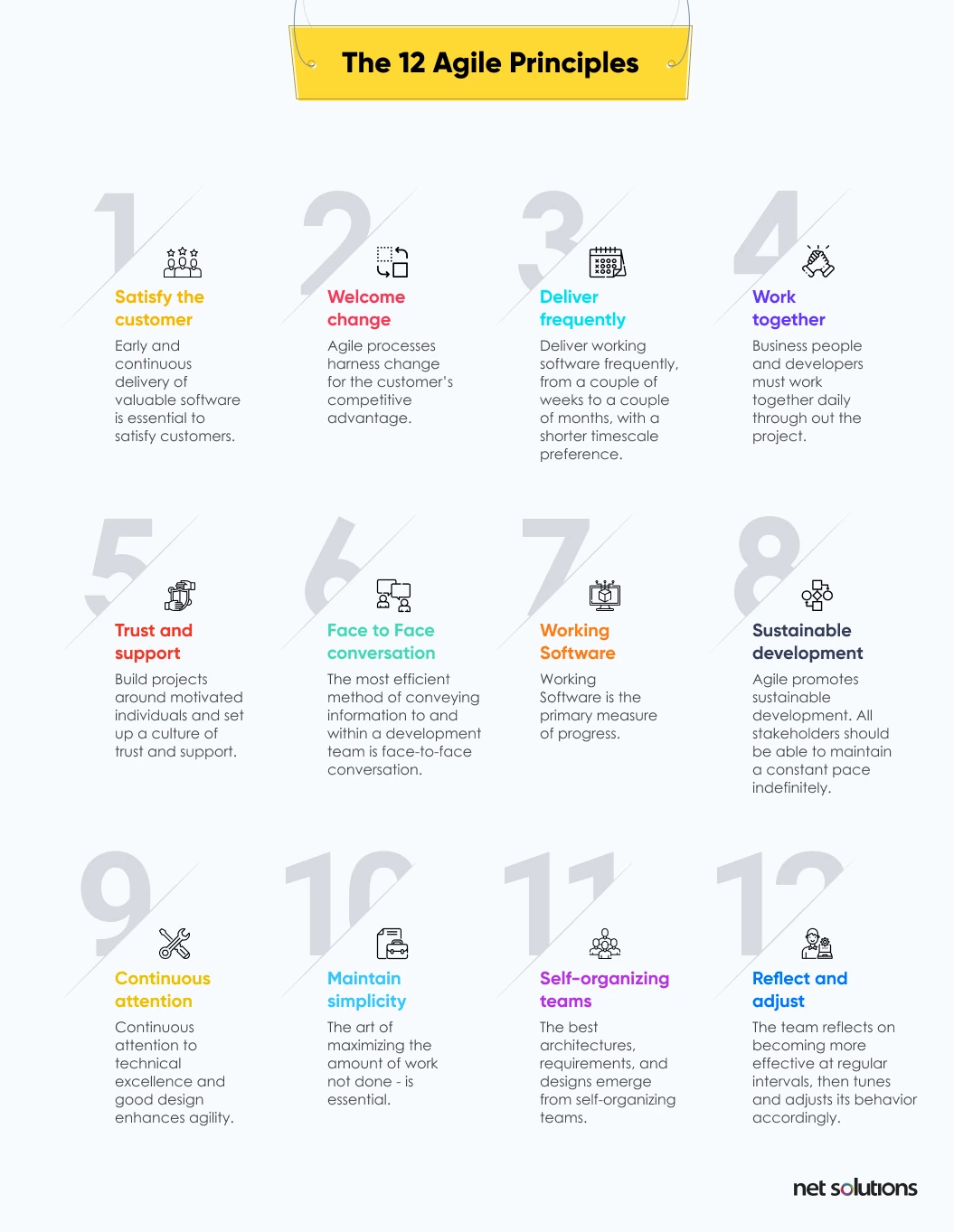
The Agile principles and values method focuses on building software in stages and phases to release its versions (user stories in agile) in specific periods or sprints. Unlike the traditional process, Agile does not build software after collating all the requirements at once but allows iterations and flexibility throughout the process. These agile principles build a structure of human collaboration and responsive processes.
The 4 Values of the Agile Manifesto
As mentioned earlier, the Manifesto comprises four foundational values and twelve supporting Agile principles to focus on delivering high-quality software. The Agile Manifesto focuses on people, communication, responsiveness, and product. Here’s a look at the 4 Agile values in detail.
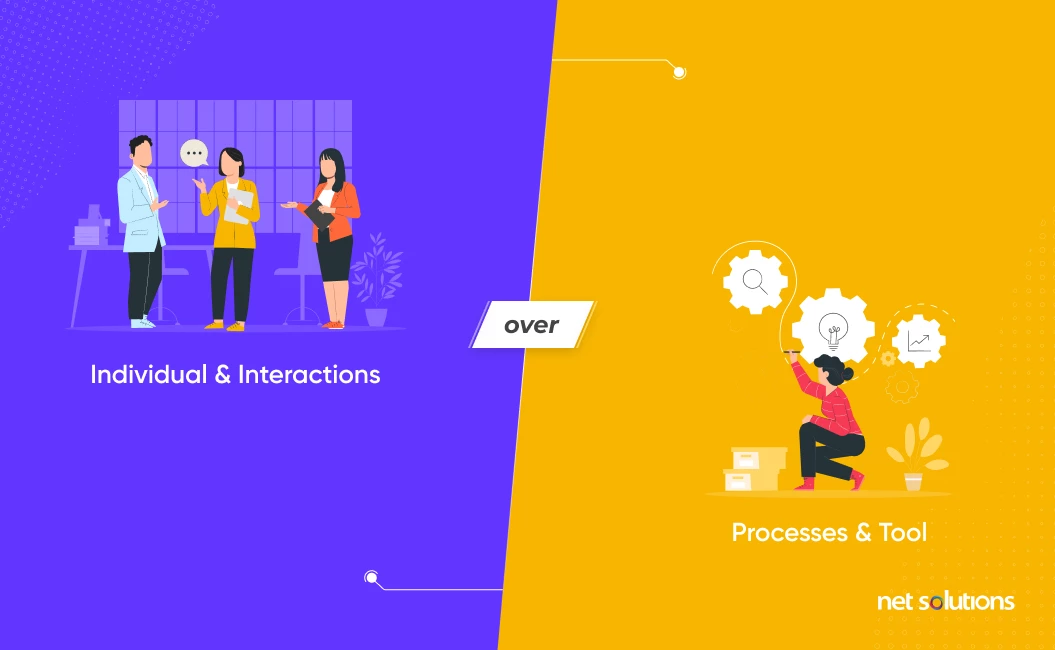
1. Individuals and Interactions Over Processes and Tools
This value focuses on communication and gives individuals and interactions greater importance than the processes and tools. If teams align, they can drive the process more effectively while responding faster to the business and functional requirements. When tools and techniques dominate the activity, the team members can become less receptive to the client’s needs and, eventually, the customers.
It is always recommended to encourage team communication instead of depending on procedures to manage the way forward. Team members can be flexible and prompt in solving a problem rather than relying on tools or processes, making it more time-oriented and less frequent.
The Agile Manifesto pushes businesses to prefer interactions and individuals over tools and processes. Development is, at the core, led by humans, and giving them preference makes the entire development process more responsive. Team support and understanding ultimately result in better workflows when agile principles are followed.
2. Working Software Over Comprehensive Documentation
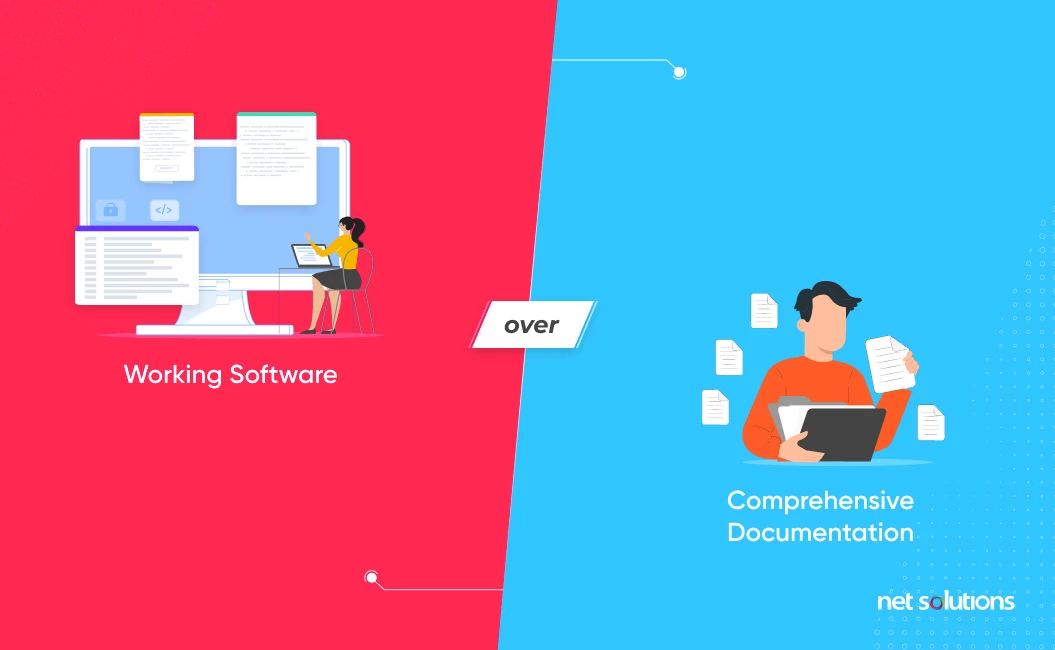
Time is the essence here – an Agile approach doesn’t wholly defy documentation but offers a developer a working software to get started. Traditional project management included extensive documentation, which involved a slack for months. This would affect the project delivery, and the delays were inescapable.
The sooner you resolve the issues with customer feedback, the faster you can move to the next problem or the project. Agile documentation streamlines programming and offers developers what they need to maintain their work without getting stalled in technicalities. It values documentation but places greater value on the actual work, so the teams are responsive and ready to accept challenges whenever required by adhering to the product mindset over the project mindset.
3. Customer Collaboration Over Contract Negotiation
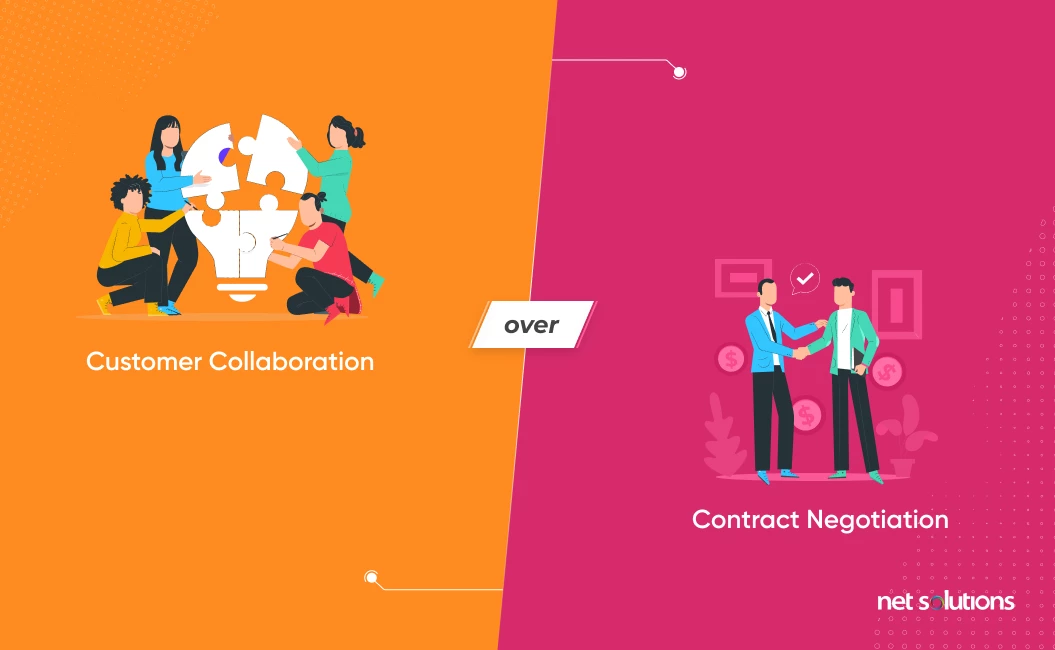
Contract negotiations usually happen when the customer and the product manager work on the product details towards the start of the process, with little scope for changes along the way. This significantly rules out the possibility of the customer participating in the development process.
The Agile Manifesto favors customer collaboration over contract negotiations, and customer collaboration refers to customers teaming up throughout the development procedure.
Agile principles involve an open-end discussion between the customer and the developers. The approach enables the coordinated teams to align better with the customer requirements. A committed product owner can help the team clarify things in real-time and adjust the tasks according to the customer’s needs.
4. Responding to Change Over Following a Plan

The usual software development life cycle approach avoids changes since they may incur higher costs. With Agile and its multiple iterations, the tasks keep changing, and with every sprint, these inputs help the project improve & create value. This value focuses on being receptive to the customers’ demands during the project rather than creating elaborate plans dismissive of changes right at the beginning.
Change is a constant process; customers might want new additions, features, etc., to the product. Adapting to their demand can help the product owner and the teams build a more accurate product and ensure their client’s satisfaction.
How to use the Agile Manifesto
If you genuinely want the Agile manifesto to work for your organization, then do the following:
- Keep your business ecosystem in mind
- Interpret the agile principles & values accordingly
- Take the time to assess and see what works
- Adjust for your team as per the core mission
- Maintain versatility for multiple software development needs
- Tailor it to make it work for your Agile projects
The Agile Manifesto values offer businesses an opportunity to strive for excellence, and the Manifesto promotes an environment of trust, transparency, teamwork, and customer collaboration.
While the software methodologies seem simple, it’s always recommended to collaborate with experts who understand the importance of building a great product and keeping the customer happy. If the Agile principles and values are practiced diligently during the software development process, they can positively impact the product and, eventually, the business.
Challenges & Criticism of the Agile Principles
Any path-breaking framework or principle will have its criticism – Agile is no exception!
Some schools of thought point out that agile principles are too hyped. The basis of this argument is that Agile wouldn’t work in all contexts or projects of organizations. Also, there are times when teams claim to have adopted agile principles, but in effect, they linger midway between abandoning traditional methods and adopting Agile.
Selective interpretation of the Agile principles and methodology per structural frameworks of organizations also sometimes creates issues. The actual working could get disoriented. Testing & Operations is not always successfully implemented, and sprints could create stress for developers.
Resistance and blockers will always happen in agile implementation – it must be seen if organizations decide to go forward after the first hurdle. Repeated testing and analysis can assist in Agile implementation. Testing, iterations, repeat testing, and imbibing Agile without giving up traditional methods might help bring down challenges.
FAQs
The Agile Manifesto streamlines organizational development, guides workflows, defines project development processes, and creates better & sustainable team management. Giving importance to people, communication, collaborations, responsiveness, and working software brings more result-oriented and efficient working systems. In an age of increased digitalization, multiple tasks management, and expansive teams, the agile principles and manifesto will always hold importance.
The agile principles call for “responding to change over following a plan.” It is unclear how organizations will make a plan, but it emphasizes the importance of following it. Responsiveness means that the plans will be flexible – product developers and owners will collaborate, share inputs, iterate, and take the next step forward in sync.
By definition of agile principles and values, ignoring individuals does not match the manifesto. The assumption would be individuals over processes, rather than tools & processes over individuals and interactions”. While the importance of software workflows is highlighted, it is in tandem with collaborative teamwork, responsiveness, and people-oriented teamwork. Agile principles insist on a balance between working software and the human factor.
Only to the extent that they both have principles and frameworks. Otherwise, design thinking focuses on the ‘why’, and agile is all about the ‘how.’ Design thinking uses an empathetic approach to ideate and discovers real-time problems that need addressing. Agile gets on to the “how” to break the project flow into parts to resolve issues. In practical working, a happy bond between the discovery (research & understanding) of the problem and the delivery (code, test, deploy) of the project/solution is what helps an organization. For greater clarity, check out this report.



